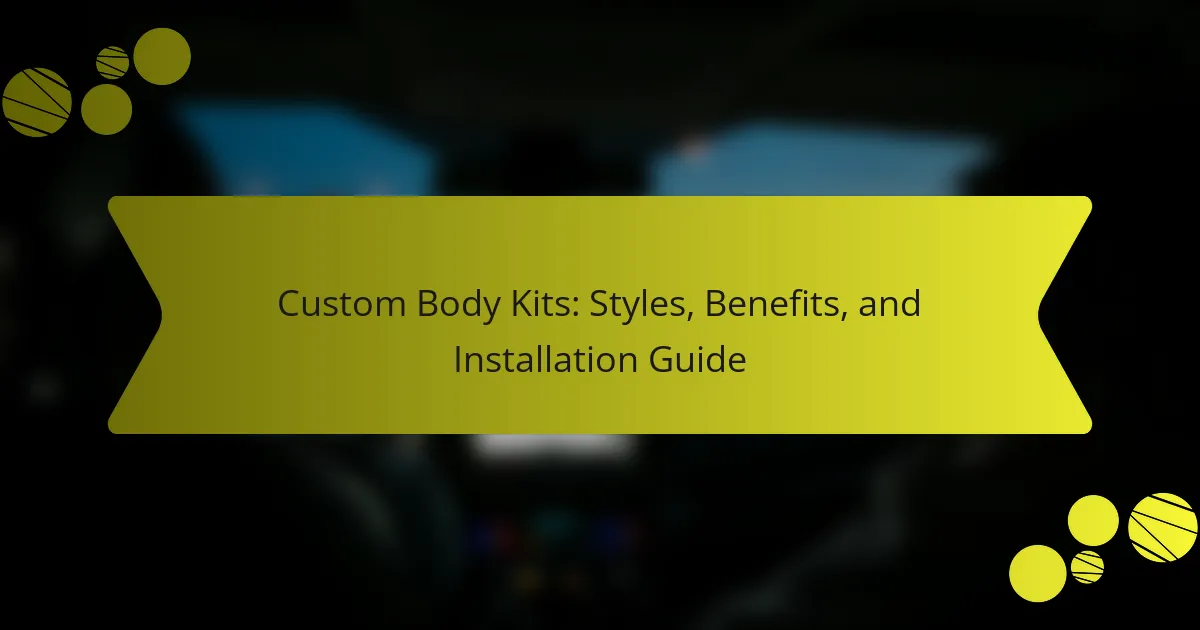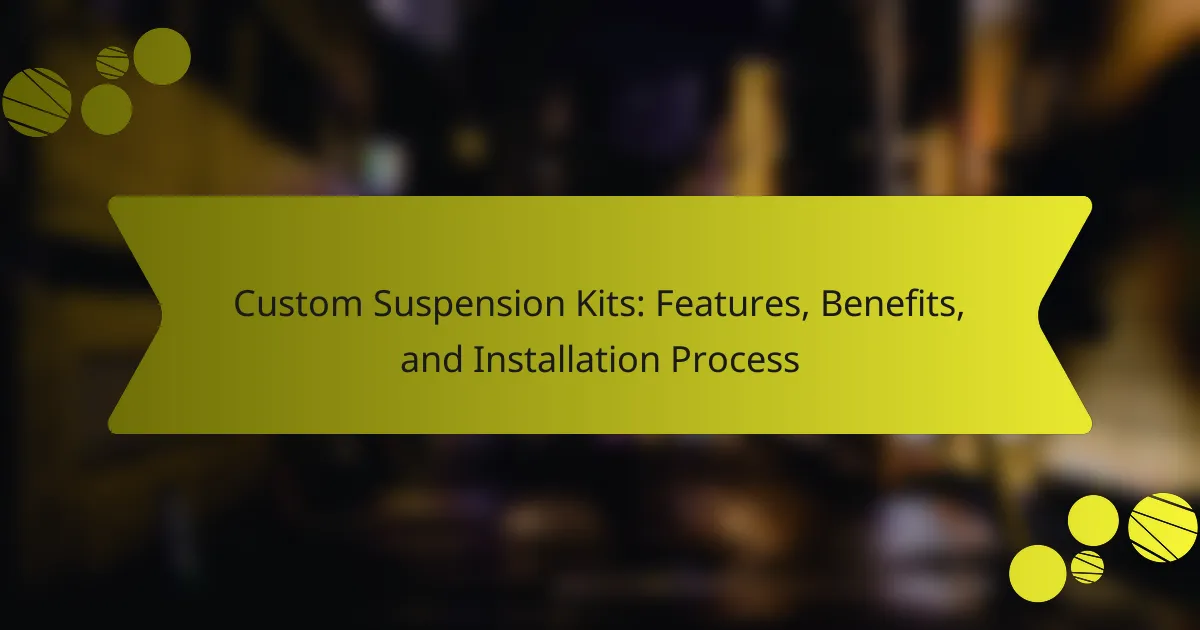Custom body kits enhance vehicle aesthetics and performance, offering various styles like aerodynamic, widebody, and off-road kits. They provide benefits such as improved airflow, increased personalization, and potential resale value. Installation requires careful consideration of vehicle compatibility and material quality. Emerging trends for 2025 include sustainable materials and advanced designs, catering to eco-conscious consumers.

What are the key styles of custom body kits?
Custom body kits come in several key styles, each designed to enhance vehicle aesthetics and performance. Popular styles include aerodynamic kits, widebody kits, and off-road kits. Aerodynamic kits improve airflow, while widebody kits expand the vehicle’s stance. Off-road kits provide durability for rugged terrains. Each style offers unique benefits tailored to specific driving needs.
How do aerodynamic body kits enhance performance?
Aerodynamic body kits enhance performance by improving airflow, reducing drag, and increasing downforce. These modifications lead to better handling, stability, and fuel efficiency. For instance, a well-designed front splitter can lower aerodynamic lift, while side skirts streamline airflow along the vehicle’s sides. Overall, these enhancements contribute to a more responsive driving experience and optimized speed.
What aesthetic styles are popular in custom body kits?
Popular aesthetic styles in custom body kits include aggressive, sleek, and retro designs. Aggressive styles emphasize sharp lines and wide body features. Sleek designs focus on smooth contours and minimalistic elements. Retro styles draw inspiration from classic vehicles, incorporating vintage aesthetics. Each style enhances the vehicle’s visual appeal and personal expression.
Which materials are commonly used in body kit construction?
Common materials for body kit construction include fiberglass, polyurethane, carbon fiber, and ABS plastic. Each material offers distinct advantages such as weight, durability, and ease of installation. Fiberglass is cost-effective but less flexible, while polyurethane provides better impact resistance. Carbon fiber is lightweight and strong, making it a premium choice. ABS plastic is versatile and commonly used for its balance of strength and affordability.

What benefits do custom body kits offer vehicle owners?
Custom body kits offer vehicle owners enhanced aesthetics, improved aerodynamics, and increased personalization options. They can transform a standard vehicle into a unique expression of style. Additionally, these kits can enhance performance by reducing drag and improving handling. Customization can also increase resale value by appealing to niche markets.
How can body kits improve vehicle aerodynamics?
Custom body kits improve vehicle aerodynamics by enhancing airflow, reducing drag, and increasing stability. These kits often include components like front splitters, rear diffusers, and side skirts, which optimize the vehicle’s shape. As a result, improved aerodynamics can lead to better fuel efficiency and handling performance. Additionally, custom body kits can be tailored to specific vehicle models, ensuring a perfect fit and maximizing aerodynamic benefits.
What impact do body kits have on resale value?
Custom body kits can enhance a vehicle’s resale value if they appeal to buyers. High-quality kits can attract enthusiasts, while poorly chosen modifications may deter potential buyers. A well-executed body kit can signal care and investment in the vehicle, increasing desirability. However, customization preferences vary widely, impacting resale outcomes significantly.
How do body kits enhance personalization and uniqueness?
Custom body kits enhance personalization and uniqueness by allowing vehicle owners to express their individual style. These kits come in various styles, including aggressive, sporty, and elegant designs. They can improve aerodynamics, which may enhance performance. Additionally, custom body kits often include unique attributes like custom paint finishes or specific materials, making each installation distinct. The installation process typically involves removing existing body panels and fitting new components, which can be done by professionals or skilled enthusiasts.
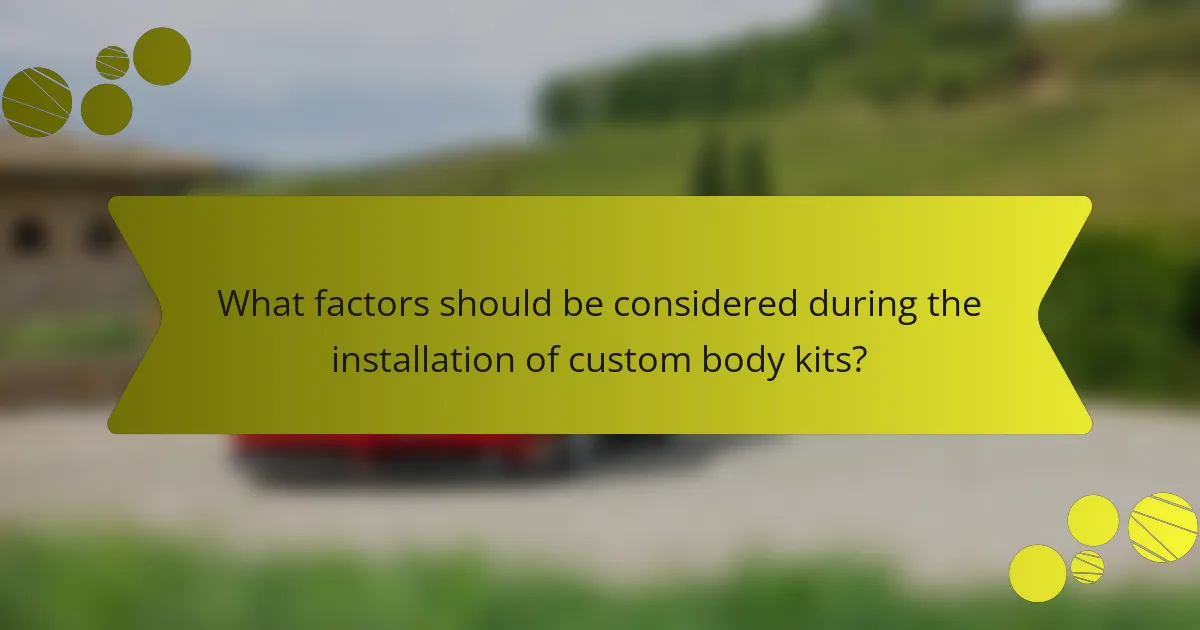
What factors should be considered during the installation of custom body kits?
Consider factors like vehicle compatibility, material quality, installation complexity, and local regulations during custom body kit installation. Ensuring proper fitment is crucial for aesthetics and performance. Additionally, evaluate the skill level required for installation, as professional help may be necessary for complex kits.
Which tools are necessary for installing body kits?
To install body kits, essential tools include a socket set, screwdrivers, pliers, a heat gun, and a measuring tape. These tools facilitate the removal of existing parts, precise measurements, and secure installation of the new components. A unique attribute of this process is the need for a heat gun to ensure proper adhesion of adhesive-backed parts.
What are the common challenges faced during installation?
Common challenges during installation of custom body kits include misalignment, inadequate tools, and complex instructions. These issues can lead to improper fitting and aesthetic concerns. Additionally, a lack of experience may cause damage to the vehicle or the kit itself. Ensuring proper preparation and utilizing professional assistance can mitigate these challenges effectively.
How can professional installation vs. DIY affect the outcome?
Professional installation typically yields better results than DIY for custom body kits. Skilled technicians ensure precise fitting and optimal performance. DIY may lead to misalignment or inadequate adhesion, affecting aesthetics and functionality. Professional services often include warranties, adding value and peace of mind.
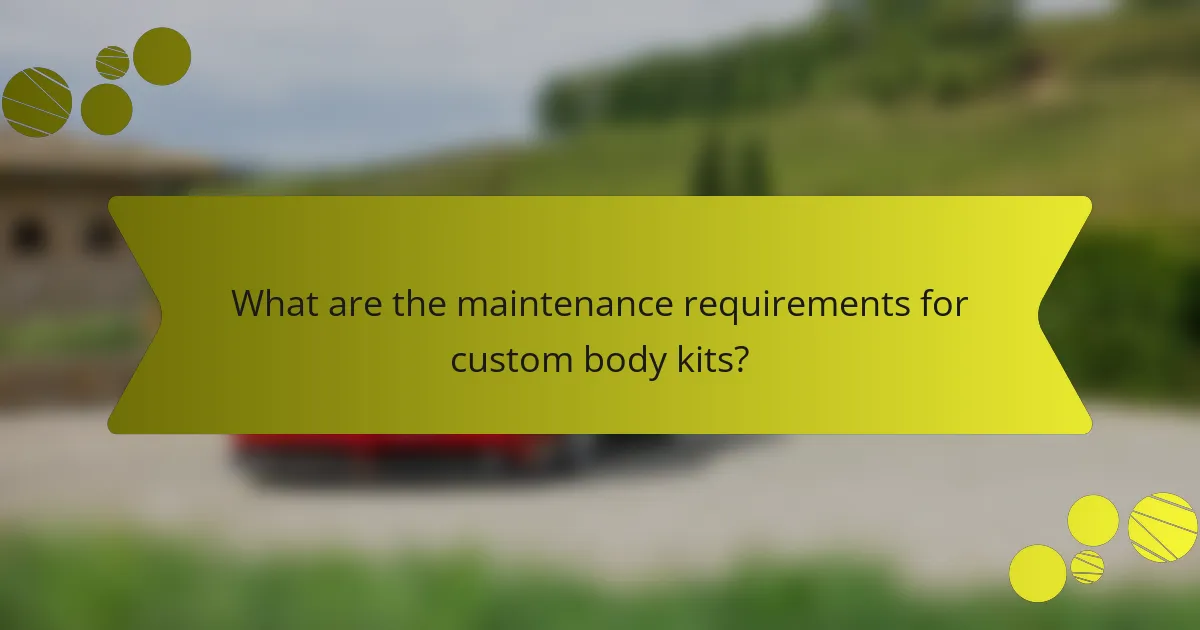
What are the maintenance requirements for custom body kits?
Custom body kits require regular cleaning, inspection, and occasional repairs to maintain their appearance and functionality. Cleaning involves using mild soap and water to avoid damage. Inspect for cracks or loose parts regularly. Repair any damage promptly to prevent further issues. Ensure proper alignment and fit during installation to avoid wear.
How can owners ensure the longevity of their body kits?
Owners can ensure the longevity of their body kits by maintaining them properly and using quality materials. Regular cleaning prevents dirt accumulation that can damage the finish. Applying protective coatings can shield against UV rays and weather elements. Additionally, avoiding rough driving conditions helps prevent physical damage. Regular inspections for wear and tear allow for timely repairs, preserving the kit’s integrity. Finally, professional installation ensures that the body kit is securely fitted, reducing the risk of detachment or damage over time.
What common repairs might be needed over time?
Common repairs for custom body kits may include paint touch-ups, reattachment of loose components, and fixing cracks or dents. Over time, wear and tear can affect the fit and finish of the kit. Regular inspections help identify issues early, ensuring longevity. Additionally, replacing damaged mounting hardware is often necessary to maintain structural integrity.
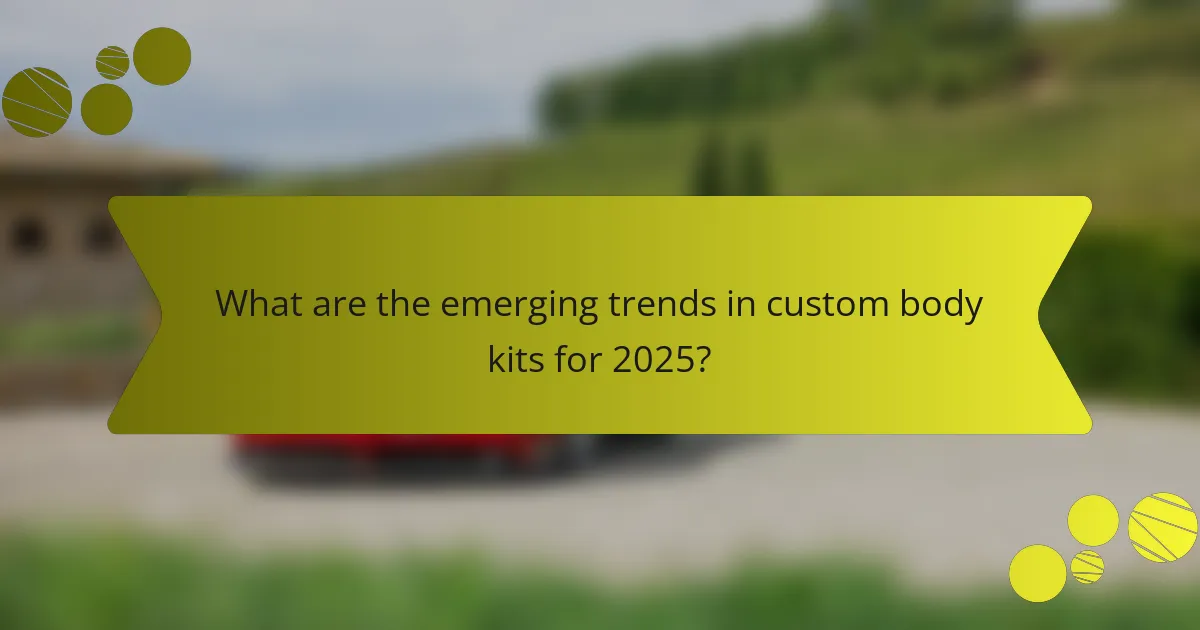
What are the emerging trends in custom body kits for 2025?
Emerging trends in custom body kits for 2025 include increased use of sustainable materials, advanced aerodynamics, and customizable designs. These innovations enhance vehicle performance and aesthetics while catering to eco-conscious consumers. Technologies such as 3D printing will also enable more personalized and intricate designs, allowing for unique expressions of style. Additionally, integration of smart features, such as LED lighting and sensors, is expected to rise, offering both functional and visual enhancements.
How is technology influencing body kit design and functionality?
Technology is revolutionizing body kit design and functionality through advanced materials and manufacturing techniques. Innovations like 3D printing enable custom designs, allowing for lighter and more aerodynamic kits. Enhanced software aids in performance optimization, ensuring better fit and finish. Smart features, such as integrated sensors, improve vehicle dynamics and safety. These advancements lead to better aesthetics and functionality, enhancing overall vehicle performance.
Which trends are gaining popularity in specific regions?
Custom body kits are increasingly popular in North America and Europe, driven by trends in personalization and performance enhancement. In North America, aggressive styling and off-road capabilities lead preferences, while European markets favor sleek, aerodynamic designs. Rising awareness of customization benefits, such as improved aesthetics and vehicle value, fuels this growth. Additionally, online communities and social media amplify interest, showcasing innovative installations and unique styles.
What role do social media and car culture play in shaping trends?
Social media and car culture significantly influence trends in custom body kits. These platforms foster communities where enthusiasts share styles, ideas, and modifications. As a result, popular designs often emerge from viral posts and influencer endorsements. Unique attributes of body kits, such as aerodynamics and aesthetics, are highlighted through user-generated content. Additionally, social media allows for real-time feedback, enabling manufacturers to adapt quickly to consumer preferences.

What expert tips can help ensure a successful body kit project?
To ensure a successful body kit project, focus on planning, quality materials, and expert installation. Start by researching styles and benefits to align with your vehicle’s aesthetics. Select high-quality materials that suit your climate and driving conditions. Finally, consider professional installation to guarantee precision and durability.
What best practices should be followed for selecting a body kit?
To select a body kit, prioritize quality, compatibility, and style preferences. Research materials like fiberglass or polyurethane for durability. Ensure the kit matches your vehicle’s make and model for a proper fit. Consider the installation process; professional installation may be necessary for complex kits. Evaluate the aesthetic impact and how it aligns with your vision for your vehicle.
What common mistakes should be avoided during installation?
Avoid misalignment, inadequate preparation, and improper tools during installation. Ensure all parts fit correctly, and check for compatibility with your vehicle model. Neglecting these aspects can lead to costly errors and diminished performance. Always follow the manufacturer’s guidelines for best results.
How can customization be balanced with functionality?
Customization can enhance aesthetics while maintaining functionality by prioritizing design that complements vehicle performance. Focus on lightweight materials and aerodynamic shapes to ensure performance isn’t compromised. Integrate features that allow for easy adjustments, enabling owners to personalize their kits without sacrificing usability. Balancing these elements creates a unique look while enhancing the driving experience.
